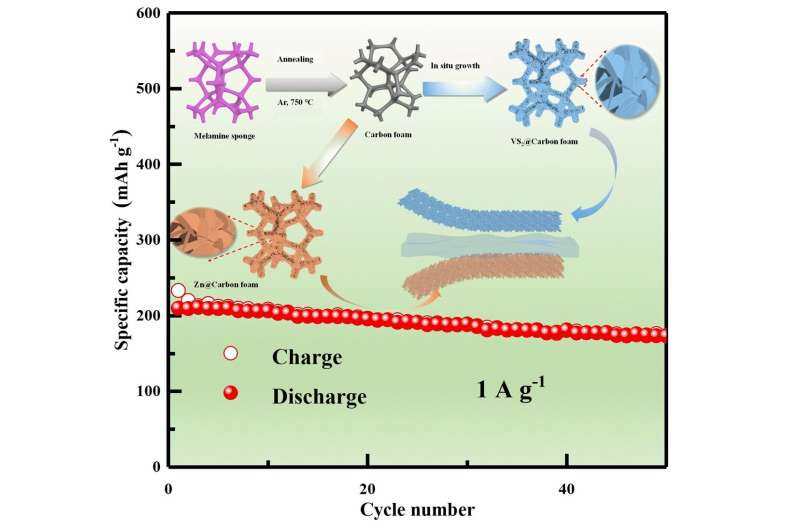A flexible self-healing quasi-solid-state zinc ion battery. Credit: Mao Yunjie
According to a study recently published in Small, a team led by Prof. Zhao Bangchuan from the Hefei Institutes of Physical Science of the Chinese Academy of Sciences fabricated a flexible vanadium disulfide material (VS2@CF) by growing the VS2 nanosheet arrays on carbon foam (CF) using a simple hydrothermal method.
In recent years, wearable energy storage devices have become indispensable in our lives due to their vast application foreground. Flexibility and safety are two important points of flexible battery to focus on.
"A battery is like a hamburger. Cathode and anode are like the two slices of bread, and the electrolyte is the filling," said Mao Yunjie, first author of the study, "our solution is to prepare a low-cost flexible substrate CF by carbonizing melamine foam and fabricate flexible cathode (VS2@CF) and anode (Zn@CF)."
They used a self-healing gel (PVA/Zn (CF3SO3)2) as the electrolyte and obtained a quasi-solid zinc-ion battery with good flexibility and self-healing properties.
The secret of their success is the novel aqueous Zn-storage flexible cathode material VS2@CF, prepared by a one-step hydrothermal method. The cathode features rich active sites, good hydrophilicity, high electronic/ionic conductivity, large surface area and flexible architecture.
The VS2@CF cathode provides exceptional rate capability and ultra-long life cycle. Impressively, the flexible quasi-solid-state zinc-ion batteries using the VS2@CF cathode, Zn@CF anode and PVA/Zn (CF3SO3)2 self-healing gels can still be charged and discharged normally under different bending angles and have good self-healing properties.
The CF provided a low-cost flexible electrode substrate for flexible energy storage devices, and the PVA/Zn (CF3SO3)2 self-healing gels provided a new idea for the design of wearable electronic devices, according to the researchers.
More information: Yunjie Mao et al, Carbon Foam‐Supported VS 2 Cathode for High‐Performance Flexible Self‐Healing Quasi‐Solid‐State Zinc‐Ion Batteries, Small (2023). DOI: 10.1002/smll.202207998
Journal information: Small
Provided by Chinese Academy of Sciences
























